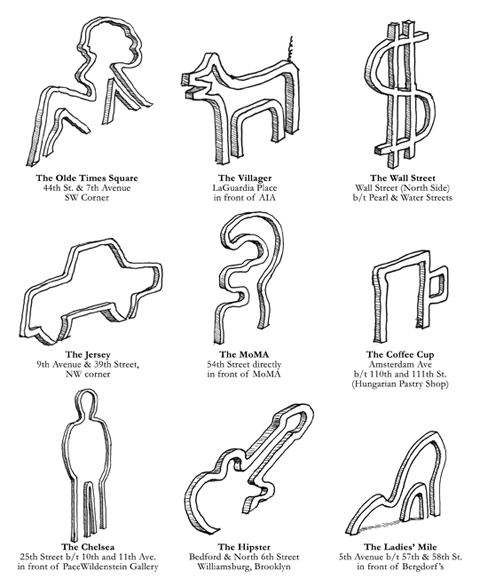
David Byrne’s new book, Bicycle Diaries (new in hardback from Viking), is an engaging, discursive, and often meditative memoir about the Talking Heads founder’s strange experiences bicycling through some of the world’s most distinct cities. Byrne uses W.G. Sebald’s The Rings of Saturn (one of our favorite books) as an entry point for his book. Like Sebald, Byrne attempts to synthesize history, memory, art, architecture, philosophy, science, and a host of other subjects in his writings on cities like Berlin, London, Manila, Istanbul, and San Francisco. The result is a book that is profound and very readable; Byrne communicates complex ideas in ways that are both fun to read and also highly relevant to an age of changing attitudes about how we are to get where we are going.
While hardly a political screed, Bicycle Diaries does contain a central argument: plainly put, Byrne suggests that cities that are bicycle-friendly tend to be more human-friendly, and that the modern/industrial reliance on cars and trucks has resulted in fundamental disconnects between people and their communities. In the first chapter, “American Cities,” Byrne surveys a number of decidedly unglamorous American cities like Pittsburgh, Baltimore, and Columbus, as well as smaller towns like Sweetwater, Texas. Byrne’s discussion of Detroit is particularly affecting. From the vantage of his bicycle, Byrne sees a Detroit most will miss, a place of modern ruins and decay. “In a car, one would have sought out a freeway, one of the notorious concrete arteries, and would never have seen any of this stuff,” Byrne writes. “Riding for hours right next to it was visceral and heartbreaking–in ways that looking at ancient ruins aren’t. I recommend it.”
Byrne repeatedly communicates this will to immediacy, for unmediated experiences in Bicycle Diaries. He’s the explorer of the real, trying to understand why folks don’t ride bikes in Buenos Aires, or trying to figure out the cultural significance of Imelda Marcos to the people of the Philippines, or pondering the brutal fauna of Australia. Byrne’s bike rides, as well as his music and art careers, give the book something like a center, but Bicycle Diaries thrives on digressions, asides on ring tones or the Stasi or amateur backyard wrestling or the history of PowerPoint. We loved these moments: it’s when Byrne relates the sad history of George Eastman, founder of Kodak, or when he tells the story of Australian outlaw legend Ned Kelly that Byrne best communicates the thrill of exploration.
Byrne’s voice is ever-earnest and never didactic. There’s a plainness and honesty to his delivery that often seems in direct contrast with the content of his message. And this is the key to the book’s success–and perhaps, more generally speaking, Byrne’s career–this ability to see, to suspend the biases and blocks and filters that too often mediate our perception, and to actually see what is actually around us. From his earliest days in the Talking Heads, Byrne displayed an uncanny knack for turning his eyes on his own culture like an alien ethnographer, yet he always did it with empathy and engagement, and never with smack of clinical remove that might otherwise characterize such a project. In Bicycle Diaries, Byrne approaches America’s reliance on roads and oil and cars with an admirable pragmatism. Where some might scold (and, implicitly, ride a high horse), Byrne is always positive, pointing out the numerous advantages of returning to a community-oriented way of life, with bicycling as a simple and efficient means of getting around in lieu of the cars–and attendant urban/suburban/exurban sprawl–that keep us separated. Byrne also suggests a number of ways that communities and cities can work toward making bicycling a more viable option for their citizens. He even provides a few fun bicycle rack designs for his hometown New York (and yes, they got made).

Finally, we’d be remiss if we didn’t mention that the book itself is a beautiful aesthetic object. Why don’t more publishers skip those annoying, flimsy dust jackets, and opt instead for something like Bicycle Diaries lovely embossed cloth deal? Just a thought. There are lots and lots of black and white photographs, many by Byrne himself, that genuinely shed light on Byrne’s narrative (the design here is of course reminiscent of Sebald’s use of photographs, only Byrne’s aren’t cryptic and actually make sense in the text). It’s great to love both the content and the design of a book, but we’d really expect nothing less from Byrne. It’s also great when a hero of ours lives up to and then surpasses our expectations–we’ve always loved Byrne’s music and his ideas, so it’s great that we can add books to that list. Highly recommended.

Thanks. I was pondering whether to buy this book. I’ll inspect it closer in the bookshop this afternoon. The Sebald influence is promising.
LikeLike
[…] rate, unlike David Byrne, who openly admitted to following Sebald’s path in his 2008 memoir Bicycle Diaries. (Cody does namecheck David Byrne […]
LikeLike